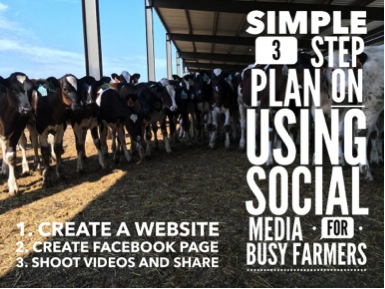
”If I do this, I put a target on my back.”
“I understand why it’s important, but I don’t get this stuff.”
These are some of the reactions I’ve heard since joining the dairy industry to promote the use of social media to connect and engage with our consumers.
And I get it. You’re already running a family business, caring for your herd, monitoring the markets, and planning your next farm improvement. With that workload, not many people are looking to add “marketing” to their list of professional hats they get to put on every day.
The good news is it’s much easier than you think. And it can have a huge impact – especially if more and more of your fellow dairy farmers begin to tell their stories along with you.
Dairy is unique – no other commodity varies the way we do from state to state, or even from farm to farm. It might be due to your climate, which breeds you prefer, or who you sell to. Those decisions are up to you. But there are some people out there who might think your way isn’t the way it should be done. And many times, these people have never set foot on your – or any other – farm.
But if you think you don’t have the time to be your own advocate, consider the following:
1. Today’s consumers are even farther removed from farming than you think they are. And they’re going to keep moving in that direction. We need to connect with them now.
According to a Land O Lakes survey, 64 percent of teens don’t know anyone who works in agriculture. That’s a lot of kids that don’t understand farm life, and for as great as school farm tours are, they aren’t going to reach them all. In fact, my kids’ schools have never taken a farm field trip, and we’ve lived in three different school districts in both large and small cities. But unfortunately, the internet most certainly will reach them, which brings me to point No. 2.
2. Modern agriculture’s most vocal critics are aggressive online and are constantly experimenting with new technology (360-degree video, drones, virtual reality, and so forth). These groups understand how fear-based marketing tactics can go viral and influence those that are trying to find answers. Online content helps fund their programs, helps recruit new people, and helps spread their anti-agriculture messages. We simply cannot let those groups dominate online conversations about dairy and about the way our food is made in general.
3. I believe we need everyone to join together so our voices can be heard. What’s always been interesting to me is that when there’s a problem on a farm (i.e. a farm accident or weather-related disaster) and that farmer needs help, everyone in the ag community comes right away to harvest the crop, milk the cows, and take care of our own. When it comes to agriculture’s voice online, there’s only a small percentage of farmers taking the time to advocate and they need our help. It’s time to join together and raise our voices.
We can do this. We can come together. We can use both face-to-face and online advocacy to reach future generations of our consumers. We need to show them the time you put in to caring for these wonderful animals that make their food taste so amazing.
Here’s a three-step plan on getting started.
- Create a farm website.
- Create a Facebook Farm Page.
- Shoot some video/photos and share them.
This plan may look like a lot of work, but you can do most of it in just minutes through your smartphone.
In a future blog post, I’ll give you the specifics for each part of the plan. If you don’t believe you have the time or know-how to get this done, I hope you can find someone on the farm that would be interested and have time to work on this.